*NURSING > QUESTIONS & ANSWERS > NR 566 Test Bank Questions for Weeks 5-7 With Answers Already Passed and Graded A (All)
NR 566 Test Bank Questions for Weeks 5-7 With Answers Already Passed and Graded A
Document Content and Description Below
NR 566 Test Bank Questions for Weeks 5-7 Week 5: Ch. 18, 19, 27, 37 Week 6: Ch. 22, 31, 38, 44 Week 7: 48, 49, 50, 51 Week 5 Ch. 18 Drugs Affecting the Hematopoietic System 1.Kenneth is taking w... arfarin and is asking about what he can take for minor aches and pains. The best recommendation is: A. Ibuprofen 400 mg three times a day B. Acetaminophen, not to exceed 4 grams per day C. Prescribe acetaminophen with codeine D. Aspirin 640 mg three times a day ____ 2. Juanita had a DVT and was on heparin in the hospital and was discharged on warfarin. She asks her primary care provider NP why she was getting both medications while in the hospital. The best response is to: A. Contact the hospitalist as this is not the normal guideline for proscribing these two medications and she may have had a more complicated case B. Explain that warfarin is often started while a patient is still on heparin because warfarin takes a few days to reach effectiveness C. Encourage the patient to contact the Customer Service department at the hospital as this was most likely a medication error during her admission D. Draw anticoagulation studies to make sure she does not have dangerously high bleeding times ____ 3. The safest drug to use to treat pregnant women who require anticoagulant therapy is: A. Low molecular weight heparin B. Warfarin C. Aspirin D. Heparin ____ 4. The average starting dose of warfarin is 5 mg daily. Higher doses of 7.5 mg daily should be considered in which patients? A. Pregnant women B. Elderly men C. Overweight or obese patients D. Patients with multiple comorbidities ____ 5. Cecil and his wife are traveling to Southeast Asia on vacation and he has come into the clinic to review his medications. He is healthy with only mild hypertension that is well controlled. He asks about getting “a shot” to prevent blood clots like his friend Ralph did before international travel. The correct respond would be: A. Administer one dose of low-molecular weight heparin 24 hours before travel B. Prescribe one dose of warfarin to be taken the day of travel C. Consult with a hematologist regarding a treatment plan for Cecil D. Explain that Cecil is not at high risk of a blood clot and provide education about how to prevent blood clots while traveling ____ 6. Robert, age 51 years, has been told by his primary care provider (PCP) to take an aspirin a day. Why would this be recommended? A. He has arthritis and this will help with the inflammation and pain. B. Aspirin has anti-platelet activity and prevents clots that cause heart attacks. C. Aspirin acidifies the urine and he needs this for prostrate health. D. He has a history of GI bleed, and one aspirin a day is a safe dose. ____ 7. Sally has been prescribed aspirin 320 mg per day for her atrial fibrillation. She also takes aspirin four or more times a day for arthritis pain. What are the symptoms of aspirin toxicity she would need to be evaluated for: A. Tinnitus B. Diarrhea C. Hearing loss D. Photosensitivity ____ 8. Patient education when prescribing clopidogrel includes: A. Do not take any herbal products without discussing with the provider B. Monitor urine output closely and contact the provider if it decreases C. Clopidogrel can be constipating, use a stool softener if needed D. The patient will need regular anticoagulant studies while on clopidogrel ____ 9. For patients taking warfarin INRs are best drawn: A. Monthly throughout therapy B. Three times a week throughout therapy C. Two hours after the last dose of warfarin to get an accurate peak level D. In the morning if the patient takes their warfarin at night ____ 10. Patients receiving heparin therapy require monitoring of: A. Platelets every 2 to 3 days for thrombocytopenia that may occur on Day 4 of therapy B. Electrolytes for elevated potassium levels in the first 24 hours of therapy C. INR throughout therapy to keep in the range around 2.0 D. Blood pressure for hypertension that may occur in the first 2 days of treatment ____ 11. The routine monitoring recommended for low molecular weight heparin is: A. INR every 2 days until stable then weekly B. aPTT every week while on therapy C. Factor Xa levels if patient is pregnant D. White blood cell count every 2 weeks ____ 12. When writing a prescription for warfarin it is common to write ____ on the prescription. A. OK to substitute for generic B. The brand name of warfarin and Do Not Substitute C. PRN refills D. Refills for 1 year ____ 13. Education of patients who are taking warfarin includes discussing their diet. Instructions include: A. Avoiding all vitamin K-containing foods B. Avoiding high vitamin K-containing foods C. Increasing intake of iron-containing foods D. Making sure they eat 35 grams of fiber daily ____ 14. Patients who are being treated with epoetin alfa need to be monitored for the development of: A. Thrombocytopenia B. Neutropenia C. Hypertension D. Gout ____ 15. The FDA issued a safety announcement regarding the use of erythropoiesis-stimulating agents (ESAs) in 2010 with the recommendation that: A. ESAs no longer be prescribed to patients with chronic renal failure B. The risk of tumor development be explained to cancer patients on ESA therapy C. Patients should no longer receive ESA therapy to prepare for allogenic transfusions D. ESAs be prescribed only to patients younger than age 60 years ____ 16. When patients are started on darbepoetin alfa (Aranesp) they need monitoring of their blood counts to determine a dosage adjustment in: A. 6 weeks if they are a cancer patient B. 1 week if they have chronic renal failure C. 2 weeks if taking for allogenic transfusion D. Weekly throughout therapy ____ 17. Jim is having a hip replacement surgery and would like to self-donate blood for the surgery. In addition to being prescribed epogen alpha he should also be prescribed: A. Folic acid to prevent megaloblastic anemia B. Iron, to start when the epogen starts C. An antihypertensive to counter the adverse effects of epogen D. Vitamin B12 to prevent pernicious anemia ____ 18. Monitoring for a patient being prescribed iron for iron deficiency anemia includes: A. Reticulocyte count 1 week after therapy is started B. Complete blood count every 2 weeks throughout therapy C. Hemoglobin level at 1 week of therapy D. INR weekly throughout therapy ____ 19. Patient education regarding taking iron replacements includes: A. Doubling the dose if they miss a dose to maintain therapeutic levels B. Taking the iron with milk or crackers if it upsets their stomach C. Iron is best taken on an empty stomach with juice D. Antacids such as Tums may help the upset stomach caused by iron therapy ____ 20. Patients with pernicious anemia require treatment with: A. Iron B. Folic acid C. Epogen alpha D. Vitamin B12 ____ 21. The first lab value indication that Vitamin B12 therapy is adequately treating pernicious anemia is: A. Hematocrit levels start to rise B. Hemoglobin levels return to normal C. Reticulocyte count begins to rise D. Vitamin B12 levels return to normal ____ 22. Patients who are beginning therapy with Vitamin B12 need to be monitored for: A. Hypertensive crisis that may occur in the first 36 hours B. Hypokalemia that occurs in the first 48 hours C. Leukopenia that occurs at 1 to 3 weeks of therapy D. Thrombocytopenia that may occur at any time in therapy Week 5 Chapter 19: Drugs Affecting the Immune System ____ 1. Attenuated vaccines are also known as: A. Killed vaccines B. Booster vaccines C. Inactivated vaccines D. Live vaccines ____ 2. Live attenuated influenza vaccine (FluMist) may be administered to: A. All patients over 6 months of age B. Patients between age 2 years and 49 years with no risk factors C. Patients with a URI or asthma D. Pregnant women ____ 3. The reason that two MMR vaccines at least a month apart are recommended is: A. The second dose of MMR “boosts” the immunity built from the first dose B. Two vaccines 1 month apart is the standard dosing for all live virus vaccines C. If the two MMR vaccine doses are given too close together there is a greater likelihood of severe localized reaction to the vaccine D. Only 95% of patients are fully immunized for measles after the first vaccine, with 99% having immunity after two doses of MMR ____ 4. MMR vaccine is not recommended for pregnant women because: A. Pregnant women do not build adequate immunity to the vaccine B. There is a risk of the pregnant women developing measles encephalopathy C. There is a risk of the fetus developing congenital rubella syndrome D. Pregnant women can receive the MMR vaccine ____ 5. If the MMRV (measles, mumps, rubella, and varicella) combined vaccine is ordered to be given as the first MMR and varicella dose to a child the CDC recommends: A. Parents be informed of the increased risk of fever and febrile seizures over the MMR plus varicella 2 shot regimen B. Patients must also receive MMRV as the second dose of MMR and varicella in order to build adequate immunity C. Patients be premedicated with acetaminophen 15 minutes before the vaccine is given D. Patients should not be around pregnant women for the first 48 hours after the vaccine is given ____ 6. The rotavirus vaccine (RotaTeq, Rotarix): A. Is a live vaccine that replicates in the small intestine, providing active immunity against rotavirus B. Should not be administered to infants who are or may be potentially immunocompromised C. Is not given to an infant who has a febrile illness (temperature greater than 100.5°F) D. All of the above ____ 7. Varicella vaccine is recommended to be given to patients who are: A. HIV positive with a CD4+ T-lymphocyte percentage less than 15 percent B. Taking corticosteroids (up to 2 mg/kg/day or less than 20 mg/day) C. Pregnant D. Immunocompromised ____ 8. Zoster vaccine (Zostavax) is: A. A live varicella zoster vaccine from the same strain used to develop the varicella vaccine B. Effective in preventing varicella zoster in patients of all ages C. Recommended for patients age 40 to 80 who have had chickenpox D. Administered at the same time as other live vaccines, as long as they are given the same day ____ 9. True contraindications to diphtheria, tetanus, and acellular pertussis (DTaP or Tdap) vaccine include: A. Fever up to 104°F (40.5°C) after previous DTaP vaccine B. Family history of seizures after DTaP vaccine C. Adolescent pregnancy D. Anaphylactic reaction with a previous dose ____ 10. Hepatitis B vaccine (HBV) is contraindicated in patients who: A. Were born less than 32 weeks gestation (give first dose at age 6 months) B. Are pregnant C. Are on hemodialysis D. Are allergic to yeast ____ 11. Human papillomavirus (HPV) vaccine (Gardasil, Cervarix): A. Is a live virus vaccine that provides immunity to six strains of HPV virus B. Has a common adverse effect of syncope within 15 minutes of giving the vaccine C. Should not be given to males younger than age 12 years D. May be given to pregnant women ____ 12. Influenza vaccine may be administered annually to: A. Patients with egg allergy B. Pregnant patients C. Patients age 6 weeks or older D. Patients with acute febrile illness ____ 13. Immune globulin serums (IGs): A. Provide active immunity against infectious diseases B. Are contraindicated during pregnancy C. Are heated to above body temperature to kill most hepatitis, HIV, and other viruses such as parvovirus D. Are derived from pooled plasma of adults and contain specific antibodies in proportion to the donor population ____ 14. Hepatitis B immune globulin (HBIG) is administered to provide passive immunity to: A. Infants born to HBsAg-positive mothers B. Household contacts of hepatitis-B virus infected people C. Persons exposed to blood containing hepatitis B virus D. All of the above ____ 15. Rho(D) immune globulin (RhoGAM) is given to: A. Infants born to women who are Rh positive B. Sexual partners of Rh positive women C. Rh negative women after a birth, miscarriage, or abortion D. Rh negative women at 36 weeks gestation ____ 16. Tuberculin purified protein derivative (PPD): A. Is administered to patients who are known tuberculin-positive reactors B. May be administered to patients who are on immunosuppressives C. May be administered 2 to 3 weeks after an MMR or varicella vaccine D. May be administered the same day as the MMR and/or varicella vaccine ____ 17. Diane may benefit from cyclosporine (Sandimmune). Cyclosporin may be prescribed to: A. Treat rheumatoid arthritis B. Treat patients with corn allergy C. Pregnant patients D. Treat patients with liver dysfunction ____ 18. Azathioprine has significant adverse drug effects, including: A. Hypertension B. Hirsutism C. Risk of cancer D. Gingival hyperplasia Week 5 Chapter 27 Anemia Pernicious anemia is treated with: A. Folic acid supplement B. Thiamine supplement C. Vitamin B12 D. Iron ____ 2. Premature infants require iron supplementation with: A. 10 mg/day of iron B. 2 mg/kg per day until age 12 months C. 7 mg/day in diet D. 1 mg/kg per day until adequate intake of iron from foods ____ 3. Breastfed infants should receive iron supplementation of: A. 3 mg/kg per day B. 6 mg/kg per day C. 1 mg/kg per day D. Breastfed babies do not need iron supplementation ____ 4. Valerie presents to clinic with menorrhagia. Her hemoglobin is 10.2 and her ferritin is 15 ng/mL. Initial treatment for her anemia would be: A. 18 mg/day of iron supplementation B. 6 mg/kg per day of iron supplementation C. 325 mg ferrous sulfate per day D. 325 mg ferrous sulfate TID ____ 5. Chee is a 15-month-old male whose screening h [Show More]
Last updated: 1 year ago
Preview 1 out of 25 pages
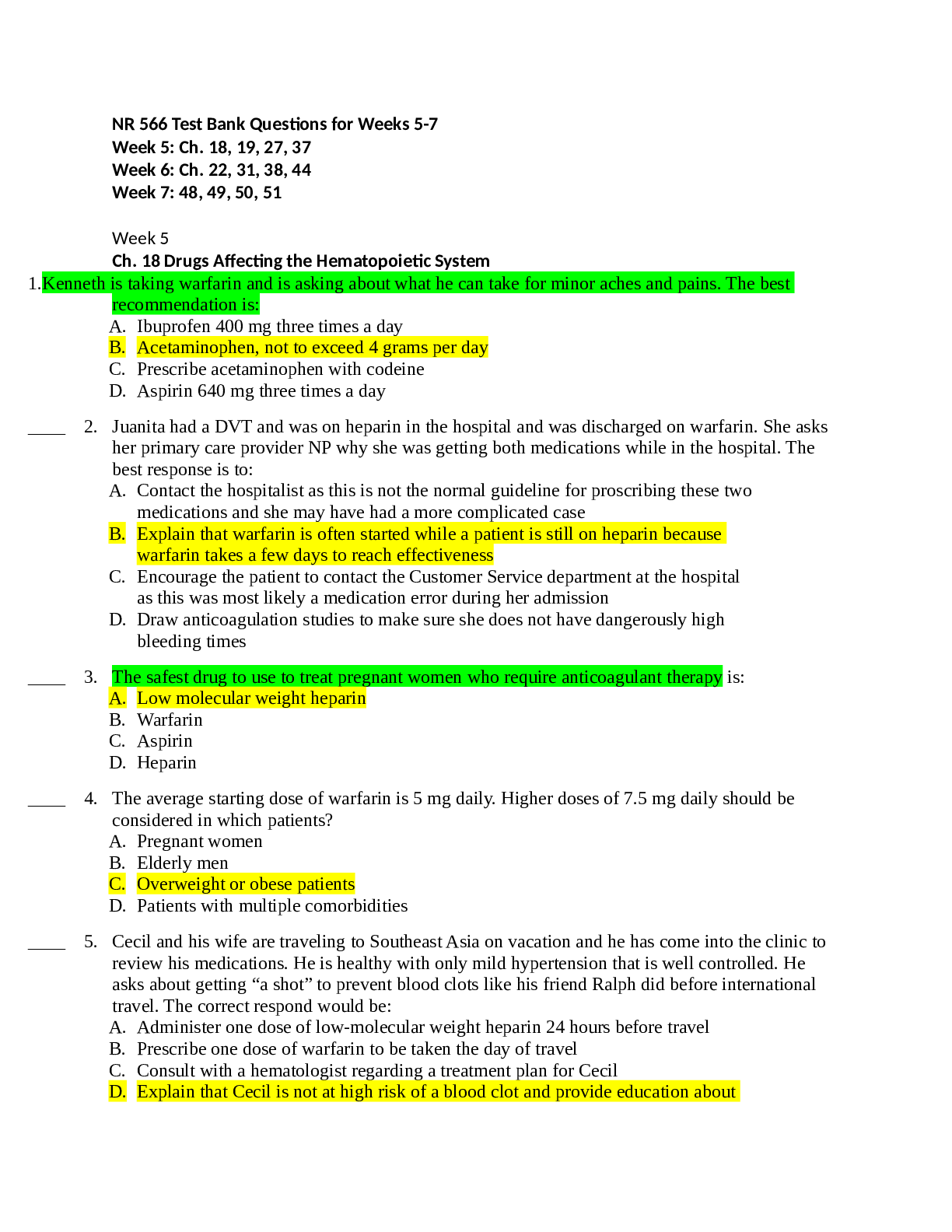
Buy this document to get the full access instantly
Instant Download Access after purchase
Add to cartInstant download
We Accept:

Reviews( 0 )
$14.00
Document information
Connected school, study & course
About the document
Uploaded On
Apr 15, 2022
Number of pages
25
Written in
Additional information
This document has been written for:
Uploaded
Apr 15, 2022
Downloads
0
Views
255

.png)
.png)
.png)
.png)
.png)
.png)
.png)
.png)
.png)
.png)
.png)

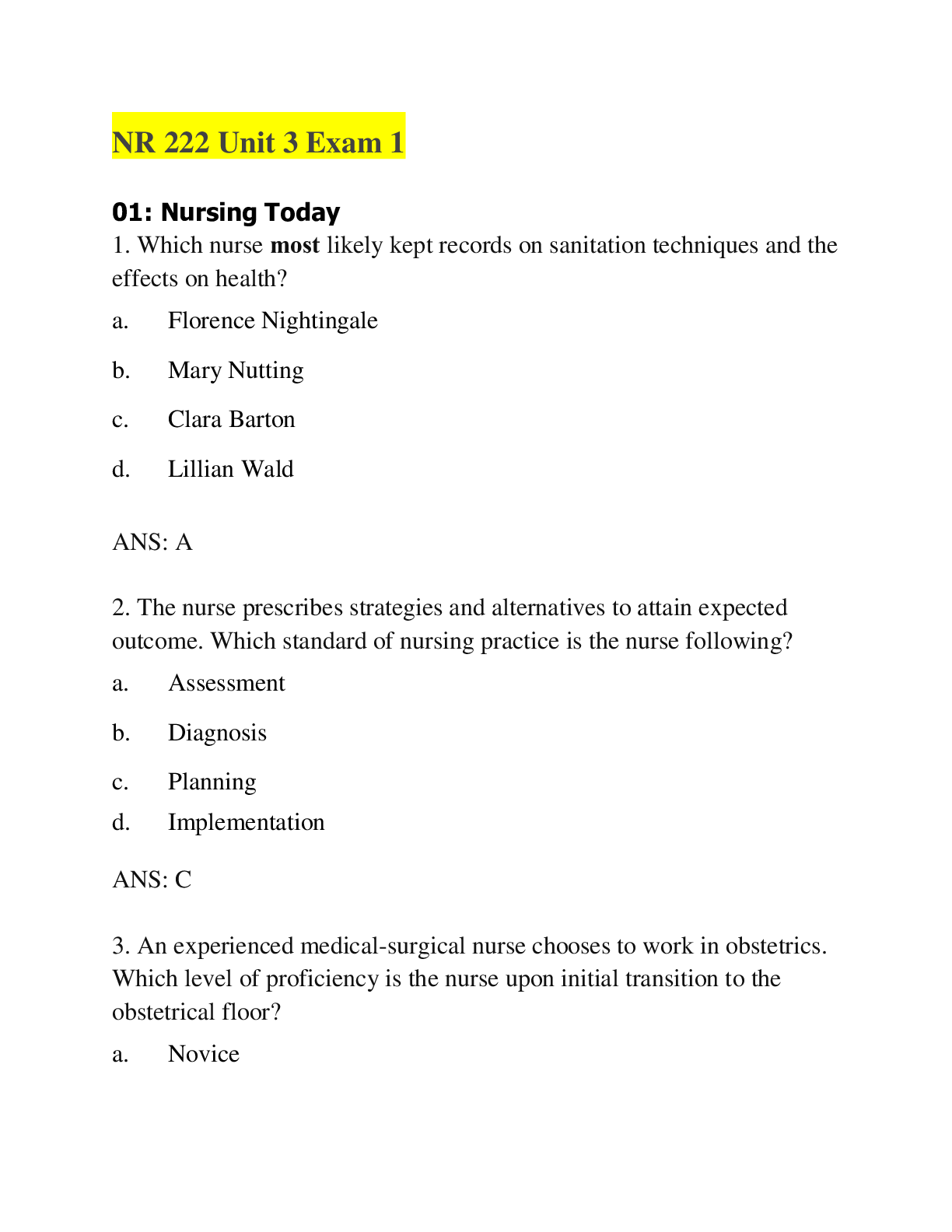
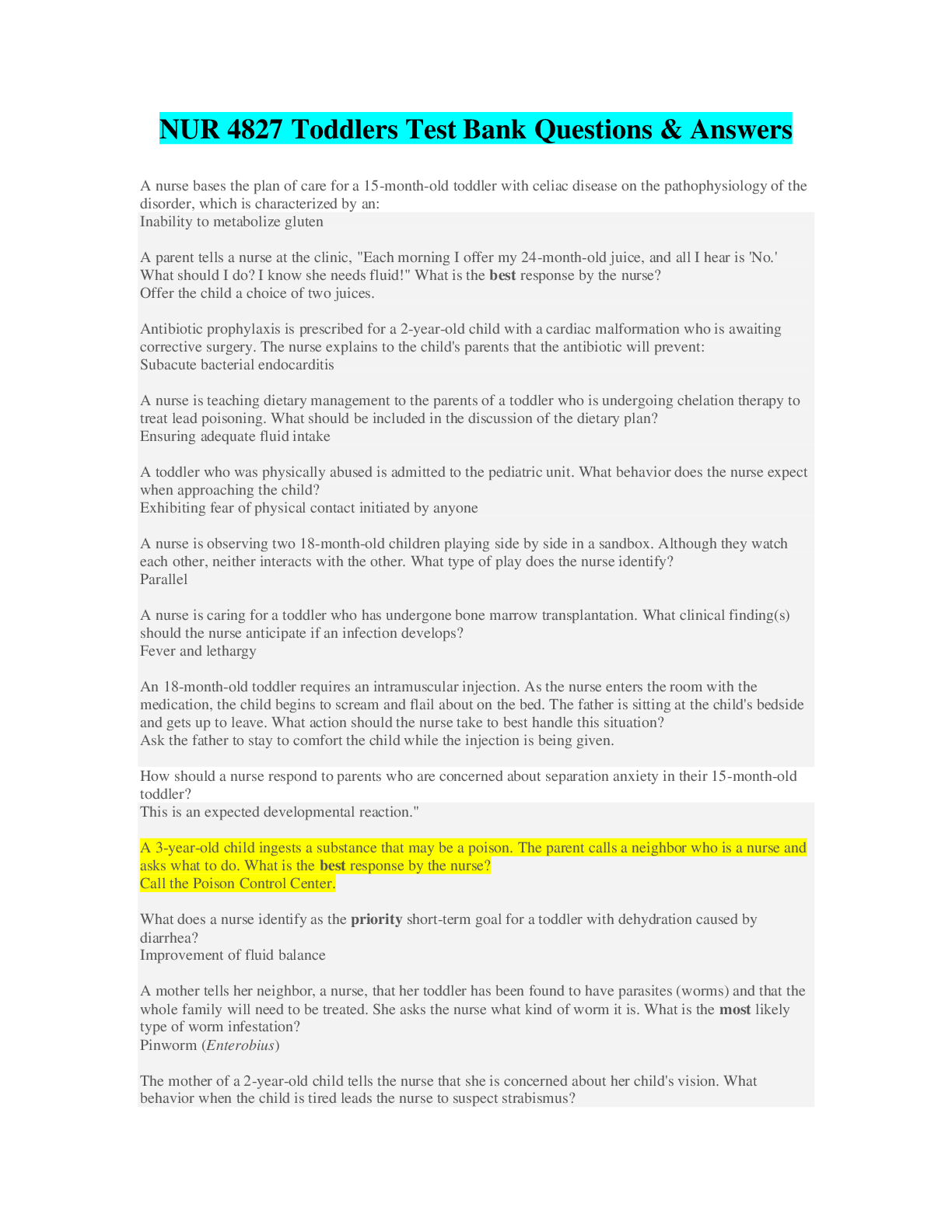
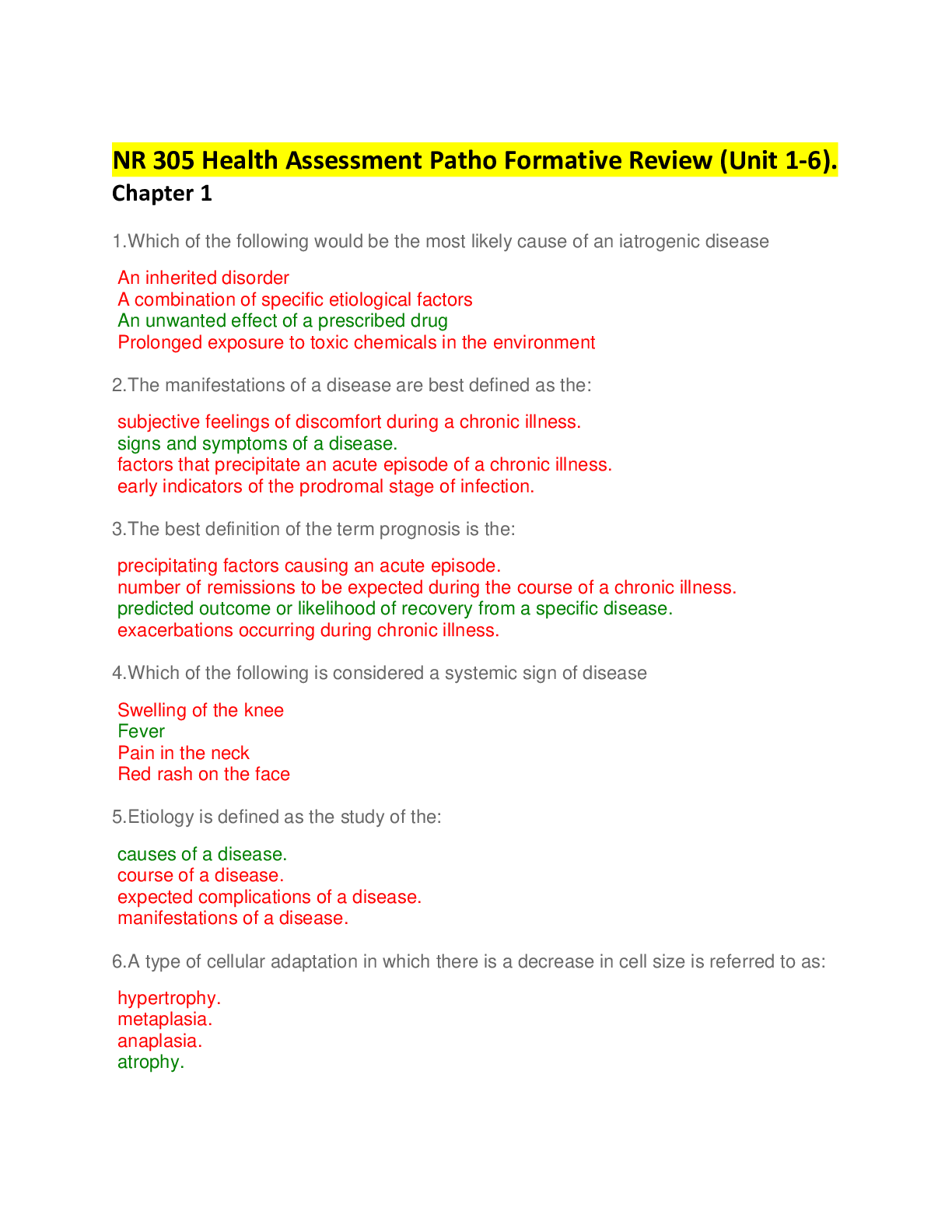
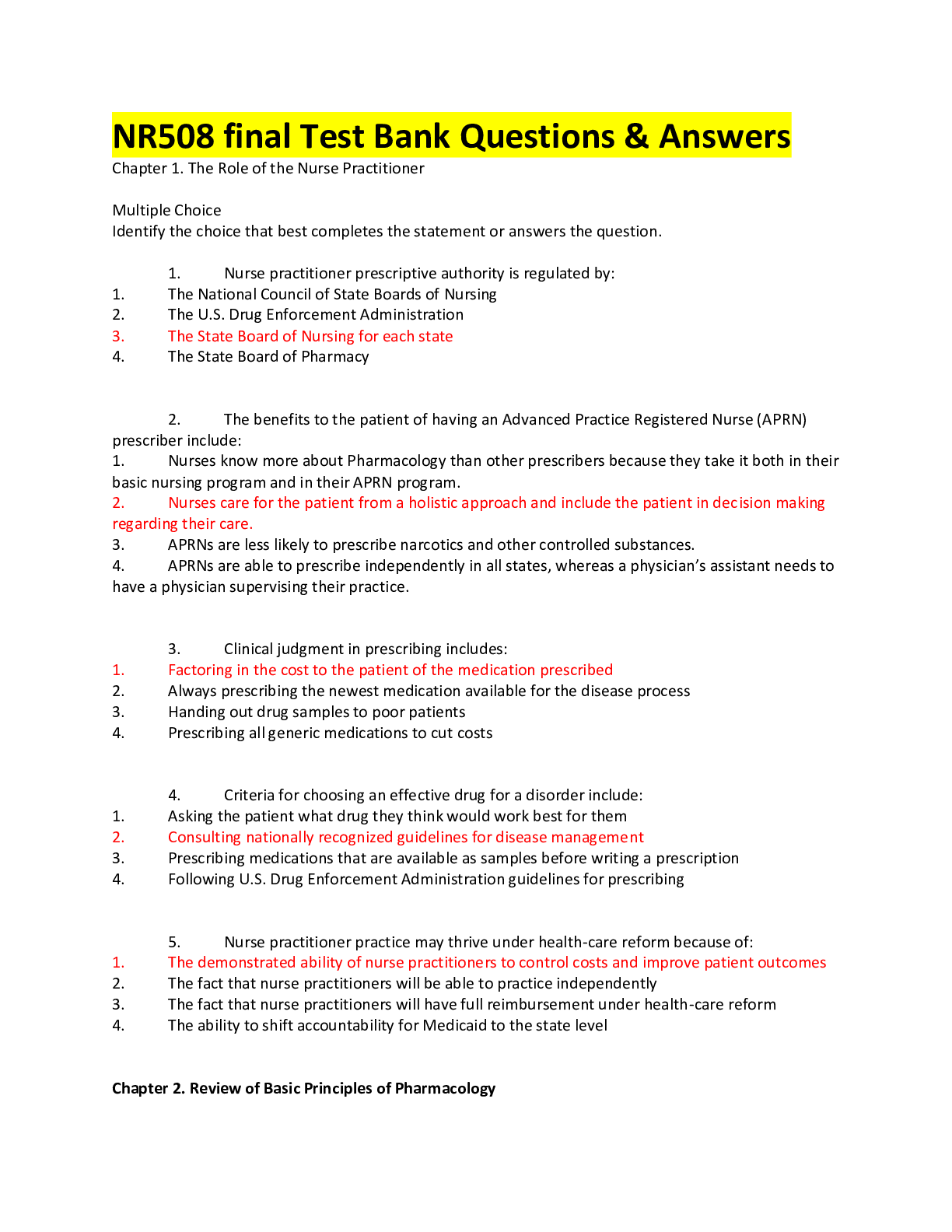




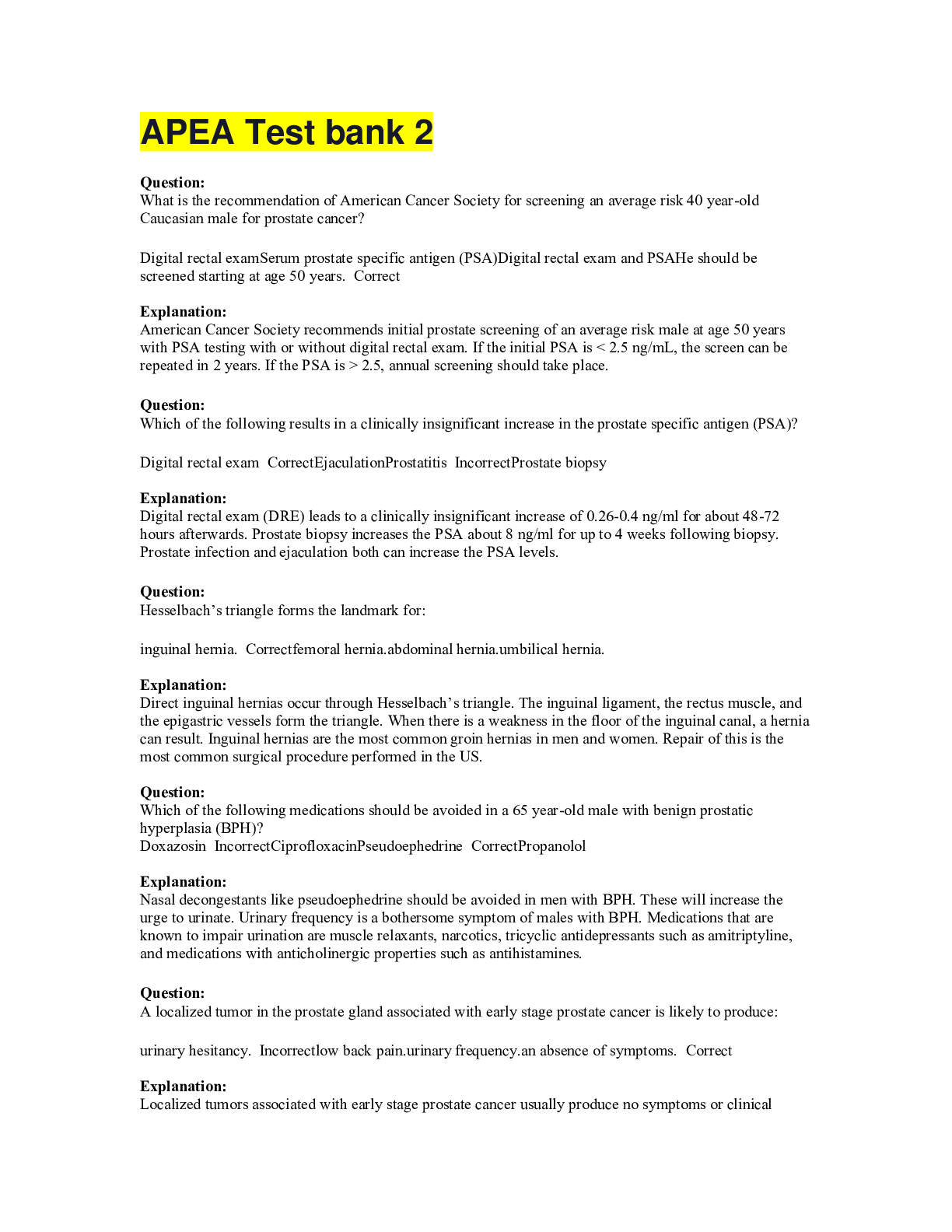
 ans.png)
, 100% Correct, Download to Score A.png)
, 100% Correct, Download to Score A.png)

